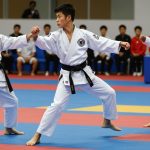Top Strategies for Preventing Injuries in Professional Rugby: A Comprehensive Guide
Understanding the Importance of Injury Prevention in Rugby
Rugby, whether it’s Rugby Union or Rugby League, is a high-contact sport that comes with a significant risk of injuries. The physical demands and the intense nature of the game make it crucial for players, coaches, and medical staff to prioritize injury prevention. According to a study on the epidemiology of orthopedic injuries in rugby, the incidence and severity of injuries can have a profound impact on a player’s career and overall health[5].
Injury prevention is not just about avoiding time off the field; it’s also about ensuring the long-term health and well-being of athletes. Here’s why it’s so important:
In parallel : Exploring the Impact of Barometric Pressure Variations on Skydiving Performance
- Impact on Performance: Injuries can disrupt training and competition schedules, affecting team performance and player morale.
- Health and Well-being: Chronic injuries can lead to long-term health issues, such as arthritis, concussions, and other medical conditions.
- Economic and Emotional Costs: Injuries can result in significant medical expenses and emotional distress for both the players and their families[3].
Adopting Proper Techniques and Training Methods
One of the most effective strategies for preventing injuries in rugby is to ensure that players adopt and practice proper techniques. Here are some key points to consider:
Importance of Technique
Proper technique is essential for minimizing the risk of injury. For example, in rugby, a poorly executed tackle can lead to injuries such as concussions, shoulder injuries, or knee ligament tears. Coaches and trainers must emphasize the correct execution of movements and tackles to protect players.
Also read : Discover the best pistol gel blasters for every adventure
Training Methods
- Gradual Progression: Training programs should gradually increase in intensity and load to allow players to adapt without overexertion.
- Specific Drills: Incorporate specific drills that mimic game scenarios to prepare players for the physical demands of the sport.
- Strength and Conditioning: Focus on building strength, particularly in the core, legs, and upper body, to enhance stability and resilience during contact[2].
Use of Protective Equipment and Gear
The right equipment can make a significant difference in preventing injuries.
Essential Equipment
Here are some pieces of equipment that are crucial for rugby players:
- Mouthguards: Mandatory for protecting teeth and gums.
- Headgear: Though not always required, headgear can provide additional protection against head injuries.
- Scrum Caps: These protect the ears and head during scrums.
- Protective Pads: For shoulders, elbows, and knees, especially for younger players or those in high-impact positions[3].
Recovery and Rest: The Unsung Heroes of Injury Prevention
Recovery and rest are often overlooked but are critical components of injury prevention.
Importance of Rest
Rest allows the body to repair and strengthen muscles after intense training. Without adequate rest, the body cannot recover effectively, increasing the risk of injury. Here are some tips:
- Scheduled Rest Days: Include rest days in the training program to allow for full recovery.
- Active Recovery: Engage in light activities like stretching, yoga, or swimming to aid in recovery without overexertion[3].
Post-Training Recovery Techniques
- Massage: Helps reduce muscle inflammation and improve blood circulation.
- Cold Baths: Known as cryotherapy, this can reduce muscle soreness and inflammation.
- Hydration: Proper hydration is essential for muscle recovery and overall health.
Nutrition and Supplementation: Fueling the Athlete
Nutrition plays a vital role in injury prevention by ensuring that the body has the necessary fuel to perform and recover.
Nutritional Strategies
- Balanced Diet: Focus on a balanced diet rich in proteins, carbohydrates, and healthy fats.
- Hydration: Adequate hydration is crucial for performance and recovery.
- Supplementation: Use supplements judiciously, focusing on natural sources and integrating supplements only when necessary. For example, protein shakes can help with muscle recovery, and omega-3 fatty acids can reduce inflammation[1].
Leveraging Technology for Injury Prevention
Modern technology offers several tools that can help in injury prevention and management.
Player Tracking and Data Analysis
- GPS Tracking: Devices like those from Catapult allow for real-time tracking of player movements, helping coaches manage training loads and prevent overexertion.
- Video Analysis: Capture videos from multiple angles to analyze player movements and identify potential risk factors for injuries[4].
Example: Catapult Technology
Catapult’s technology includes GPS tracking vests that monitor player movements, heart rate, and other physiological data. This helps coaches make informed decisions about training and recovery, ensuring players are not overworked and reducing the risk of injury.
“En fournissant aux praticiens des données complètes et individualisées grâce à la technologie Catapult, nous leur permettons de prendre des décisions éclairées pour donner la priorité aux performances et à la sécurité des joueurs,” said Matt Cross, responsible for scientific and medical operations at Premiership Rugby[4].
Practical Strategies for Coaches and Trainers
Here are some practical strategies that coaches and trainers can implement to prevent injuries:
Periodization of Training
- Phased Training: Break down the training season into phases, each with specific goals and intensities.
- Load Management: Monitor and manage the training load to avoid overexertion.
Injury Risk Factors
- Identify High-Risk Players: Use data and medical history to identify players who are at higher risk of injury.
- Customized Training Plans: Develop training plans that are tailored to the individual needs and risk factors of each player.
Communication and Education
- Player Education: Educate players on proper techniques, injury prevention strategies, and the importance of reporting any discomfort or pain.
- Team Communication: Ensure open communication between coaches, trainers, medical staff, and players to address any concerns promptly.
Detailed Strategies for Specific Positions
Different positions in rugby have unique demands and risk factors. Here are some detailed strategies for common positions:
Forwards
- Scrum and Lineout Techniques: Ensure proper technique in scrums and lineouts to avoid injuries to the neck, back, and knees.
- Tackling and Contact Drills: Focus on safe tackling techniques and contact drills to reduce the risk of concussions and other head injuries.
Backs
- Agility and Speed Training: Incorporate agility and speed drills to improve quick changes of direction and reduce the risk of hamstring and groin injuries.
- Passing and Catching Drills: Practice passing and catching to avoid injuries to the shoulders and hands.
Table: Comparison of Injury Prevention Strategies
| Strategy | Description | Benefits | Examples |
|---|---|---|---|
| Proper Techniques | Emphasize correct execution of movements and tackles. | Reduces risk of injuries like concussions and ligament tears. | Tackling drills, scrum techniques. |
| Protective Equipment | Use of mouthguards, headgear, scrum caps, and protective pads. | Protects against head, mouth, and joint injuries. | Mandatory in many youth and professional leagues. |
| Recovery and Rest | Include rest days and active recovery techniques. | Allows body to repair and strengthen muscles. | Massage, cold baths, hydration. |
| Nutrition and Supplementation | Balanced diet and judicious use of supplements. | Ensures body has necessary fuel for performance and recovery. | Protein shakes, omega-3 fatty acids. |
| Technology and Data Analysis | Use of GPS tracking and video analysis. | Helps manage training loads and identify risk factors. | Catapult technology, video capture during matches and training. |
| Periodization of Training | Phased training with specific goals and intensities. | Avoids overexertion and manages training load. | Break down training season into phases. |
| Customized Training Plans | Tailored plans based on individual needs and risk factors. | Reduces risk of injury by addressing specific vulnerabilities. | Use data and medical history to identify high-risk players. |
Injury prevention in professional rugby is a multifaceted approach that involves adopting proper techniques, using protective equipment, ensuring adequate recovery and rest, fueling the body with the right nutrition, and leveraging technology. By implementing these strategies, coaches, trainers, and medical staff can significantly reduce the risk of injuries, ensuring that players can perform at their best while maintaining their health and well-being.
As Marlie Packer, co-captain of the Saracens, emphasized, “Having access to detailed performance information changes the game for us and ensures that every player can perform at the highest level while prioritizing our health and safety”[4].
By combining these strategies and staying informed about the latest research and technologies, the rugby community can create a safer, more sustainable environment for athletes to thrive.











